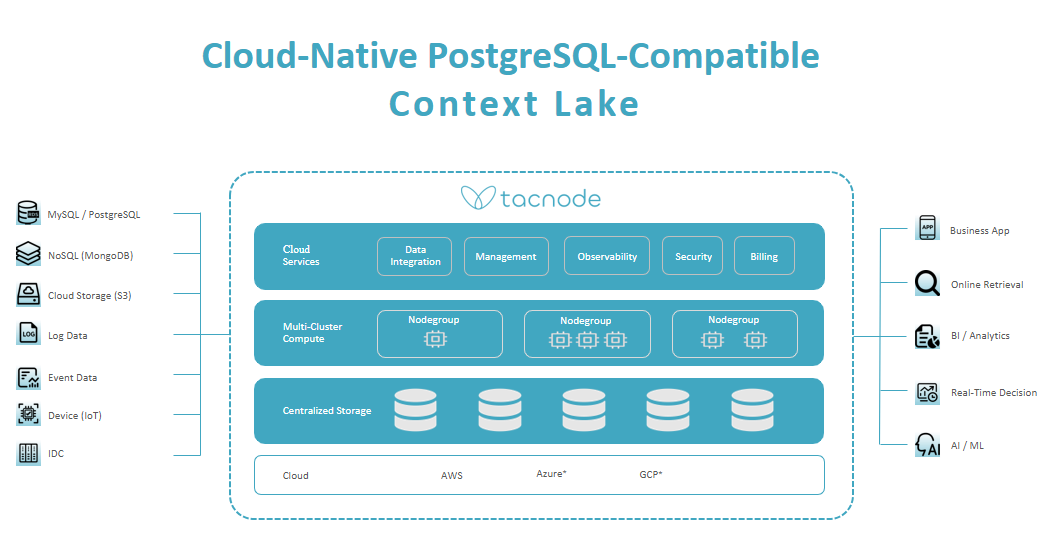Positioning
Unified AI Context
A Context Lake supports transactional databases, lakehouse solutions, and omini search within a single product. It aims to provide an exceptional user experience while significantly reducing data storage and usage barriers.

All Data: Capable of storing all structured, semi-structured, and unstructured data.
All Workloads: Supports all workloads, including simple queries, keyword searches, semantic searches, summary analytics, and combinations.
Pushing the Limits: Exceeds standard business demands in performance, accuracy, and real-time capabilities. In database contexts, it offers superior performance by effectively addressing horizontal scaling issues through distribution. Excels in data warehousing scenarios by resolving accuracy and real-time performance challenges.
Experience: Provides an agile experience for development and operation.
- Unified Storage: All data stored in one place.
- Unified Data Access: Users experience a consistent product across different scenarios, avoiding the subtle differences typical of using multiple products.
- PostgreSQL Compatible: No steep learning curve; users can quickly start using their existing relational database knowledge.
- Workload Isolation: Supports various scenarios with enhanced workload isolation.
- Self Adaptive: Automatically optimizes for specific business scenarios to ensure optimal performance.
Tacnode Context Lake
Tacnode Context Lake is compatible with PostgreSQL and optimized for multi-cloud environments. Its design philosophy integrates database, data warehouse, and search functionalities, enabling a range of operations from basic data retrieval to interactive data analytics.
- Cloud Agnostic: Supports all major cloud vendors, including AWS, Alibaba Cloud, and Tencent Cloud, with plans to support more in the future.
- Cloud Native: Fully utilizes container technology to leverage public cloud elasticity.
- PostgreSQL Compatible: Leverages PostgreSQL's robust ecosystem, toolchain, and complete SQL support, reducing the learning curve for users familiar with relational databases.

Data Ingestion Layer
Supports a wide range of data source types to meet evolving enterprise data needs. Compatible with:
- Relational databases: MySQL, PostgreSQL, and others.
- NoSQL databases: MongoDB and others for flexible storage and querying of semi-structured data.
- Cloud object storage: like Amazon S3, for managing large-scale data storage and retrieval.
- Log and event data: for processing streams of log and event data from applications.
- Internet of Things (IoT) device data: for gathering data from various IoT devices.
- IDC data: for effective management of data center operations data.
Data Storage Layer
Built on cloud storage resources, Tacnode's Centralized Storage abstraction layer efficiently manages and schedules data storage in a multi-cloud environment. Features a highly scalable storage strategy, supporting data backup and replication across cloud service providers (AWS, Alibaba Cloud, Tencent Cloud, etc.), ensuring data persistence and reliability.
Distributed Computing Layer
Features a Multi-Cluster Computing cluster called a Nodegroup, serving as Tacnode's main computational resource. Each Nodegroup consists of several computing units (Units) that can be elastically scaled according to demand. Utilizes containerization technology and a cloud-native scheduling system to optimize resource allocation and scaling, enhancing processing efficiency and overall system performance.
Cloud Services Layer
Provides a range of cloud services to meet diverse business needs, including:
- Data Integration: Simplifies data inflow and enhances integration capabilities. Management and operation services simplify daily database and Nodegroup management.
- Observability Services: Monitor system status, optimize performance, and respond promptly to system events.
- Security Services: Ensure data security and compliance.
- Billing Service: Offers transparent and flexible billing models for services used.
API and Service Layer
The top layer provides application integration and service interfaces for enterprises, supporting:
- Business application interface: Ensures efficient data access for business applications.
- Search service: Offers powerful search capabilities for real-time query needs.
- Business intelligence and analysis tools: Support data analysis and decision-making.
- Real-time decision-making platform: Enables real-time data stream processing and decision-making systems.
- AI/ML algorithm integration: Provides data support for machine learning and AI algorithms, accelerating model training and inference processes.